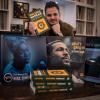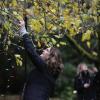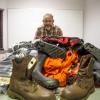April 18, 1996 - 5:00pm
Thanks to new technology called videomicroscopy and the efforts of two Malaspina University-College instructors, parasitology students can now interact with some of the most amazing creatures nature has to offer. Welcome to the wonderful microscopic world of parasites.
Biology instructor Dr. Tim Goater and instructional computing administrator Liz Hammond-Kaarremaa were on a field trip to Bamfield Marine Station with the parasitology (Biology 315) class when they all learned what a world of discovery opens up when you put a high-powered microscope, a video camera, a VCR and a TV together to investigate new parasites in the field or even at home in the lab.
"You only need to hear the excitement in the student's voices to know this is educational technology at it's best," says Hammond-Kaarremaa. "The technology allows you to magnify live marine parasites on a TV screen many thousands of times larger than the actual creature under the microscope."
The new technology allows students to observe and record live microscopic parasites in their host habitate - be it the gills of a fish, barnacles taken from the back of a whale, or the heart of a marine animal. It was at Bamfield where Goater and Hammond-Kaarremaa determined that they needed this equipment for Malaspina's students on campus.
A $7,500 grant from the Ministry of Education, Skills and Training Centre for Curriculum and Professional Development allowed Goater to buy a Lieca Wild M38 microscope capable of magnifying 400 times, an auxiliary Lietz compound microscope, a compact Panasonic video camera, a 21-inch TV monitor, and a VCR.
Once students and instructors find the tiny parasites they can record them directly onto VHS video tape which can be played back, forward and "freeze-framed" to view the creature.
Of course, once the "critter" as Goater calls them, is on video tape it can be digitized into a computer file. From there it can be edited with sound added, technical graphic details added, or, as Goater is doing, used to make an interactive CD-ROM.
In charge of editing the parasitology class' collection of creatures is third year biology student Shelley Jepps who, as Goater's microscopy assistant, helps fellow-students record the best images of the parasite they are researching as part of their classwork.
Goater is in the final stages of producing a CD ROM titled interactive parasites. This multimedia instructional tool allows students to study parasites at home at their own speed and to trace their particular area of study via sound recordings, video clips and in-depth text references by pointing and clicking their way through the compact disk's layers of multimedia information.
Goater would like to make the videomicroscopy dream complete by adding a digital titlemaker ($1,000) to record scientific data onto the edited video tape, and the ability to make photographic captures ($4,000) to Kodachrome slides to illustrate scientific articles and lectures.
Tags: In the Community






